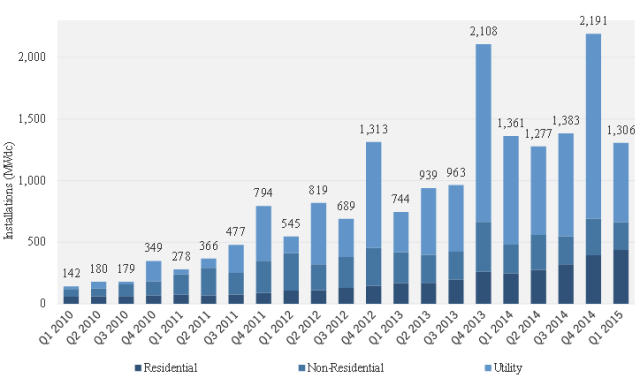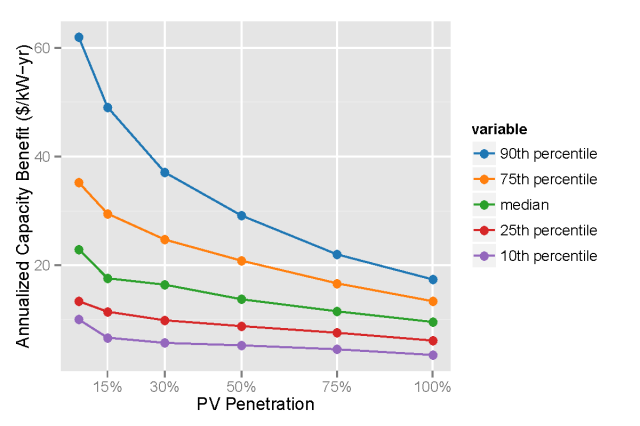Growth in the residential solar market continues apace. In the
United States, residential solar PV installations last quarter were up
11 percent over the previous quarter:


Source: http://www.greentechmedia.com/research/ussmi
The
figure illustrates this impressive growth rate (in dark blue). However,
this is growth on a very small base. By my crude calculations, less
than half a percent of American households currently have solar panels
on their roof.[1] In
those states where residential solar is starting to take hold, there
are mounting concerns that rate structures currently in place to support
residential PV will result in adopters bearing less than their fair
share of system costs. If increasing levels of distributed solar
generation puts additional pressure on grid equipment and aging
infrastructure, these concerns loom even larger.
A new EI working paper takes
a close look at how increasing levels of distributed solar generation
can impact power system costs. For me, this paper raises a timely
question: should we be paying more attention to where distributed
generation gets distributed?
Bill savings for the adopters
Before diving into the details, let’s first review the basic issues. If
you have invested in putting solar panels on your roof, chances are the
solar electricity you generate is valued at retail rates one way or
another. This is thanks to net metering policies adopted in most states.
If you consume the electricity you generate, you avoid purchasing
electricity from your utility. If you do not use all the electricity
that your solar panel is generating (it is estimated that almost half
of electricity generated by net metering customers in California is
exported), you can export the extra power to the grid and count it
against consumption within the same billing period.
As we’ve discussed before
on this blog, the marginal retail price can significantly exceed the
direct energy costs of producing a kilowatt-hour centrally. On the one
hand, many of the costs that are reflected in retail prices (e.g.
metering, billing, and infrastructure costs) are not avoided when you
put solar panels on your roof. On the other hand, solar PV generates
benefits that are not fully reflected in market prices.
So what is
the right price for distributed solar generation? Past blog posts have
touched on some elements of this value-of-solar calculation that fall
squarely in the purview of economists. But there are other important
elements that push outside the boundaries of economics. This week, we
venture into the engineering-meets-economics world of distribution
system costs.
I am no an engineer, but I am fortunately married to
one, who is a co-author of the new EI working paper. Much to the
chagrin of my kids (who’d rather be talking Frozen or fire trucks), I
have been steering the family dinner table conversation towards this
paper which looks at how distributed solar affects the electricity
distribution system. The findings should be of interest to energy
economists and engineers alike (but not so much three and five year olds
it turns out).
The distribution system meets distributed generation
A quick summary of what I’ve learned at my dinner table. If
you install solar panels on your roof, this will impact how power flows
through the distribution system that delivers power from high voltage
transmission networks to the people in your neighborhood. The cartoon
below helps to fix ideas.
Source: http://www.slideshare.net/bhagwanprasad50/transformer-basic
Some
of these impacts can reduce costs. For example, less electricity
flowing into your neighborhood during peak times can reduce pressure on
aging infrastructure (e.g. distribution lines, service transformers) and
defer the need to invest in distribution system upgrades. That’s good.
But increased PV penetration can also increase the need for investment
in hardware such as voltage regulation because distribution systems are
not designed to handle power flowing from customers back to the
substation. Not good.
The cartoon above shows a single “feeder”
(a collection of distribution lines that carry power from the high
voltage transmission system to customers). Using detailed data on all
3,000 feeders operated by the largest utility in California, PG&E,
Duncan and coauthors simulate how increased solar PV penetration on each
feeder would impact the need for system capacity upgrades, expenditures
on voltage management, etc.
On average, they find that the
levelized value of deferred investment in distribution system upgrades
(avoided costs) is small: around half a cent per kWh. This is in line
with rough estimates found in other reports that use highly aggregated
data.
But the advantage of disaggregated data is that they can look beyond
the average. It turns out that this economically insignificant average
value obscures tremendous variation in feeder-specific capacity values.
Capacity values are zero across a large majority of feeders where no
capacity upgrades are anticipated over the next ten years. But for
approximately ten percent of feeders, the picture looks quite different.
The
figure below focuses on the 298 feeders where capacity upgrades are
anticipated in the next ten years under a business-as-usual scenario.
This represents about 20 percent of the total capacity, or approximately
1 million customers.
The
figure shows that estimated capacity values exceed $60/kW-year (or
$33/MWh using their discounting and electricity production assumptions)
for approximately 30 feeders (this assumes a solar PV penetration rate
of 7.5 percent). This is almost on par with the energy value. The
median capacity value in this select group exceeds $20/kW-year ($11 per
MWh).
Although there has been much hand wringing over the
potential for voltage regulation problems, the authors find that these
problems are actually relatively small. Using PG&E’s current budget
for repairing voltage regulating equipment, they estimated that even in
extremely aggressive scenarios for PV deployment, the total costs to
ratepayers would be less than half a million dollars a year.
Distribution matters
On
average, this study finds that the average (distribution system
related) net benefits of distributed solar PV are not very significant.
However, looking beyond the average, the value of deferred investments
in distribution system infrastructure associated with a given level of
distributed generation depends significantly on how these resources are
distributed on the system. In other words, the net costs of future
distributed generation could be significantly reduced if these resources
are targeted to areas where they can generate the largest benefits.
There is precedent for targeting energy efficiency
to defer investments in transmission and distribution system upgrades…
why not solar PV? If the next generation of distributed solar incentive
programs and resource planning protocols reflect the impacts that
these resources could have on different parts of the distribution
system, the next generation of distributed resources can be more
efficiently distributed.
[1]
To estimate the number of systems, I divide GTM research estimates of
installed residential PV capacity in 2014 by the state-specific average
residential system size (as reported in Tracking the Sun,
2014). I then divide this by the US Census estimate of the number of US
households in 2014. Thanks to Naim Dargouth and Snuller Price for the
solar PV numbers!

